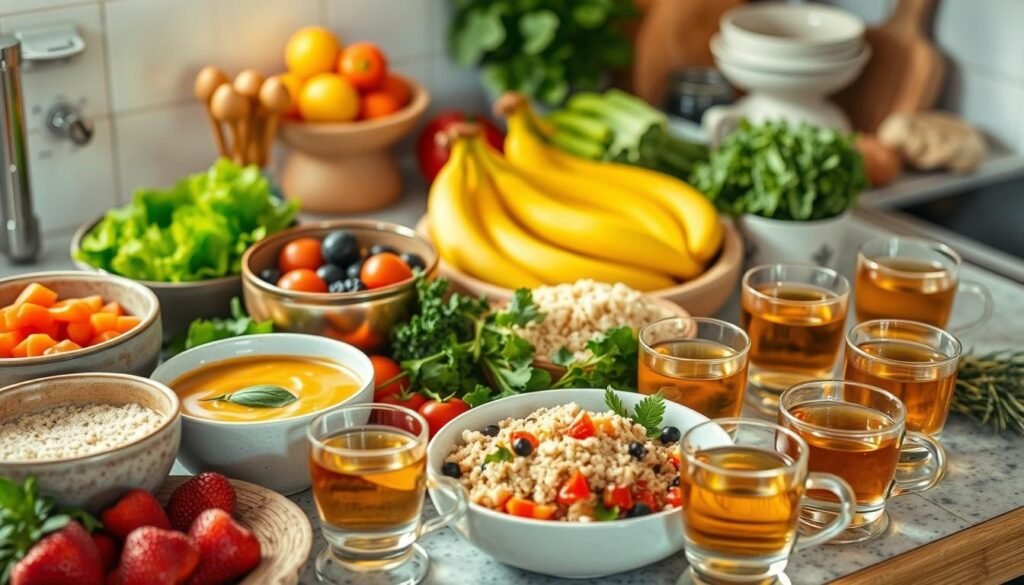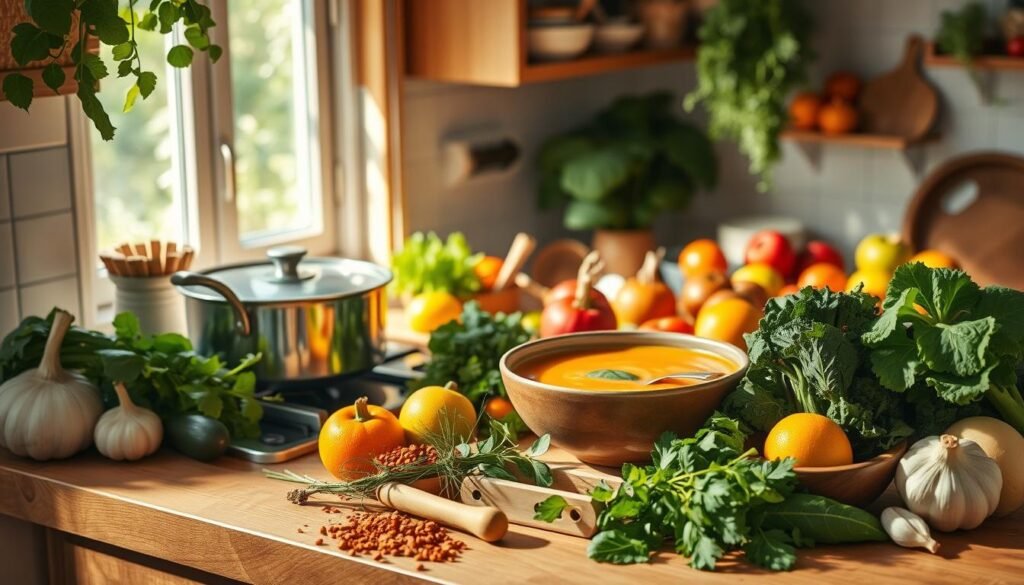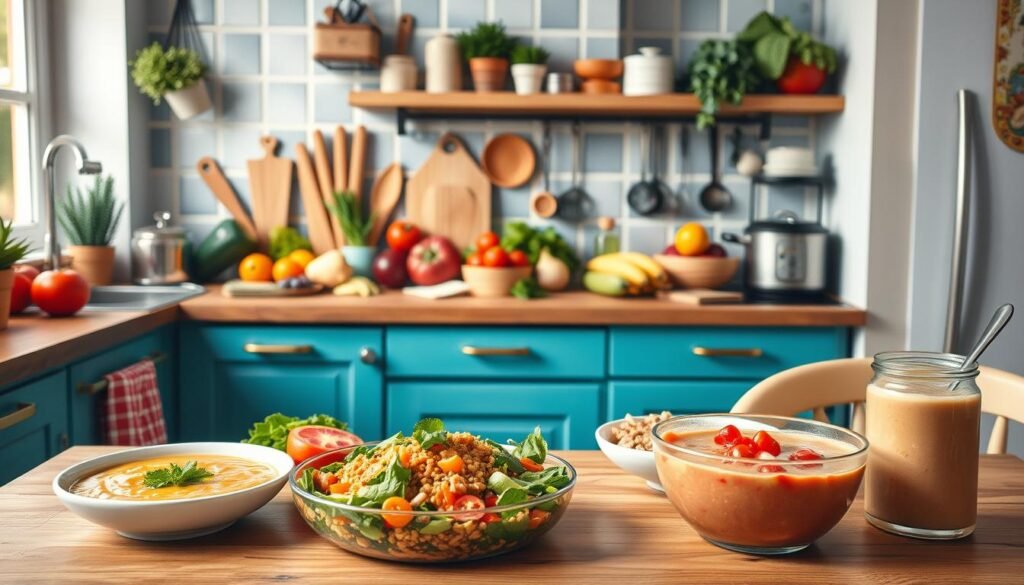Nearly 1.8 million Americans were expected to get lung cancer in 2020. It shows how critical good nutrition is while treating cancer. Easy recipes can comfort patients and give them control over what they eat. Eating well is key to better recovery and health.
This piece talks about recipes for lung cancer patients that taste good and are healthy. It shares how nutrient-rich foods and certain ways of cooking can aid their recovery journey. There are many delightful dishes offered, from smoothies to warm dinners, tailored for those recovering from cancer.
Looking for more meal ideas and recipes? Visit these sites for healthy meals and advice on handling radiation therapy for lung cancer patients.
Key Takeaways
- Easy recipes play a crucial role in the nutrition of lung cancer patients.
- Nutrient-dense foods can support recovery and enhance overall well-being.
- Comforting and tasty meals help patients maintain a sense of normalcy.
- Recipes can be customized to meet individual nutritional needs and preferences.
- Cooking methods like steaming and baking are recommended to preserve food quality.
- Collaboration with healthcare providers can optimize meal plans for better outcomes.
Understanding Nutritional Needs for Lung Cancer Patients
Lung cancer brings many nutritional challenges. Patients often lose their appetite and weight. They may find it hard to swallow and chew. So, it’s crucial to know their nutritional needs. This helps with recovery and managing symptoms.
Many lung cancer patients see benefits from changing their diet to handle side effects. Around 40% need help with meals and might get referred to care teams for this. It shows how key nutrition is during cancer care.
Eating smaller, frequent meals can be easier for patients. It’s important to eat foods that are high in calories and protein, especially if losing weight. Adding nutritional supplements to food can also boost calorie intake. Talking to a dietitian helps patients make better food choices. Many look for this advice actively.
The following table shows important nutrition tips for lung cancer patients:
| Nutritional Challenge | Recommended Strategy |
|---|---|
| Loss of appetite | Engage in fresh air activities to stimulate appetite |
| Difficulty swallowing | Opt for pureed or soft foods |
| Need for higher protein intake | Include protein-rich foods in every meal |
| Assistance with meal prep | Utilize ready meals and convenience foods |
| Seeking nutritional advice | Consult a registered dietitian nutritionist |
Lung cancer patients often turn to resources like the Lung HelpLine and online support groups for more advice on nutrition. Understanding and managing their nutrition well is key to improving their life during treatment.
Importance of Cooking with Nutrient-Dense Ingredients
Cooking with nutrient-dense ingredients is key for lung cancer patients. Nutrient-dense recipes pack meals with vitamins and minerals, without too many calories. This boosts the immune system and improves health during treatment.
Steaming, roasting, and sautéing keep the goodness in food. These techniques help patients get the most from their meals. Vitamin C, beta-carotene, and omega-3s fight cancer, aiding recovery.
Adding different whole foods makes healthy eating easy. Ingredients like leafy greens, whole grains, and lean proteins reduce inflammation. They help with healing and also prevent cancer.
The following table shows cooking methods and their nutrient benefits:
| Cooking Method | Nutritional Benefits |
|---|---|
| Steaming | Preserves vitamins and minerals effectively |
| Roasting | Enhances flavor while maintaining nutrients |
| Sautéing | Quick cooking that keeps nutrients intact |
| Blanching | Retains color and nutrient content of vegetables |
| Poaching | Soft cooking method that helps preserve delicate nutrients |
Nutrition experts, like those at The Cancer Center for Healing, offer personalized nutrition advice. They make sure diet plans meet the health goals of patients. This approach greatly improves life quality and recovery during tough times.
Comforting Recipes for Lung Cancer Patients
Finding comforting recipes for lung cancer patients can greatly improve their emotional well-being. Warm meals like soups, casseroles, and stews are comforting. They are made with lean proteins and lots of vegetables. This balances taste with health. These meals warm both the body and spirit.
Adding at least 2.5 cups of fruits and vegetables to your diet every day can lower cancer risks. They’re full of antioxidants. Meals with pearl couscous, arugula, fennel, and broccoli are nutritious and tasty. Steaming, poaching, and baking are healthy ways to cook while keeping the nutrients.
It’s crucial to offer a variety of proteins. Choices include:
- Chicken and shrimp
- Fish
- Plant-based alternatives
For those who need a gluten-free option, try rice noodles or angel hair pasta. When making comforting recipes for lung cancer, remember treatment side effects. Some people might have a dry mouth or feel nauseous. Flavorful broths and concentrated flavors can help. They’re delicious and easy to swallow.
Avoiding heavy ingredients is important. They can cause discomfort. Mixing sauteed vegetables into a light broth or sauce makes dishes enjoyable and easy to digest. Simple, nutritious meals sustain patients and help them face challenges more effectively.
| Recipe | Main Ingredients | Nutritional Benefits |
|---|---|---|
| Chicken Vegetable Soup | Chicken, carrots, spinach, broth | High in protein, vitamins, and antioxidants |
| Mushroom Risotto | Arborio rice, mushrooms, spinach | Rich in fiber, plant-based nutrients |
| Plant-Based Chili | Beans, tomatoes, spices, peppers | High protein, rich in antioxidants |
| Broccoli & Cheese Casserole | Broccoli, cheese, brown rice | Good source of calcium and fiber |
Using fresh herbs can make meals taste better. By focusing on soothing meals for patients, eating can stay enjoyable even in tough times.
Easy-to-Digest Recipes for Improved Digestion
Patients with lung cancer often need to focus on meals for digestive health. This is key when they face gastrointestinal issues. Choosing easy-to-digest recipes ensures meals are both comforting and nutritious. It makes eating enjoyable, not a chore.
Lora Reeves, a specialist at City of Hope® Cancer Center Atlanta, talks about avoiding malnutrition. She suggests eating soft, low-fiber foods. Warm cereals, plain white bread, yogurt, and chicken soup are good for digestive comfort.

Carolyn Lammersfeld points out the importance of food for energy. She says calories are crucial for energy during treatment. Adding bananas and pulp-free fruit juices helps balance the diet. They don’t upset the stomach.
It’s important to know foods to avoid. Cancer patients should stay away from lightly cooked fish and raw dairy. Also, unwashed fruits and veggies can be harmful. Fatty and spicy foods may cause tummy trouble, but this varies by person.
Adding squash to meals offers great nutritional benefits. Varieties like butternut and acorn add fiber for better digestion. Spaghetti squash is both low-calorie and fiber-rich, making it a good choice to avoid bloating. Squash fits well in easy-to-digest recipes, perfect for those focusing on meals for digestive health.
For additional support, try these juicing recipes. They are designed to ease symptoms during treatment.
High-Protein Recipes for Patients
Protein is key for recovering lung cancer patients. It helps fix tissues, boosts the immune system, and keeps health in check. High-protein meals ensure nourishment and meet dietary needs. Choosing a variety of protein sources makes meals tasty and full during treatment.
Boosting Recovery with Protein-Rich Meals
Meals rich in protein give essential nutrients to stay strong. Adding foods like dairy, lean meats, beans, and nuts makes dishes both filling and healthy. Chana Dal Dosa for breakfast provides protein, vitamins B, and phosphorus. Moong Dal Oats Tikki snacks offer flavor and health perks.
Examples of High-Protein Ingredients
To make high-protein meals, include various ingredients rich in protein. Below is a list of some great options:
| Protein Source | Type | Nutritional Benefits |
|---|---|---|
| Greek Yogurt | Dairy | High in protein, probiotics |
| Chickpeas | Legume | Rich in protein, fiber |
| Peanuts | Nuts | Good fats, protein, antioxidants |
| Eggs | Animal | Complete protein, vitamins |
| Fish (e.g., salmon) | Seafood | Rich in omega-3 fatty acids, protein |
| Cottage Cheese | Dairy | High protein, low fat |
Try Corn Dalia or Oats Idli for both protein and fiber, crucial in recovery. Smoothies are flexible, using fruits, nut butter, and dairy substitutes for tasty, nutritious boosts. They’re great for snacks or meal replacements.
Using high-protein ingredients in meals supports health and aids recovery. For more on tailored treatments and nutrition’s role in cancer recovery, see the latest lung cancer treatments here.
Immune-Boosting Recipes for Better Health
A strong immune system is key for lung cancer patients. It helps prevent infections and reduces side effects from treatment. Immune-boosting recipes feature foods full of antioxidants, vitamins, and minerals to improve immunity. Foods like garlic, ginger, leafy greens, and citrus fruits are great choices for meals.
These recipes offer nutrition and great flavors for cancer patients. They include superfoods for both taste and health. Miso soup, spinach salad, or turmeric-ginger drinks add comfort and nutrients to your diet.
- Garlic and Ginger Stir-Fry: This dish boosts immunity and adds flavor to your favorite veggies.
- Citrus Salad: With oranges and grapefruits, this dish is full of vitamin C to refresh your body.
- Kale Salad: Full of fiber and antioxidants, it’s a great addition to any meal.

Making these immune-boosting recipes takes about 20 minutes. They are fast and filled with nutrition. They cater to various diets, adding superfoods like broccoli, berries, or yogurt.
| Recipe | Calories per Serving | Total Fat (g) | Protein (g) | Fiber (g) |
|---|---|---|---|---|
| Salmon Tacos | 637 | 28 | 43 | N/A |
| Blueberry Kefir Smoothie | 355 | 13 | 15 | N/A |
| Miso Soup | 232 | 4 | 15 | N/A |
| Kale Salad | 390 | 30 | 6.6 | 6.6 |
| Fruit Salad | 311 | 18 | N/A | 8.7 |
| Broccoli Salad | 268 | 13 | N/A | 9.4 |
| Spinach Salad | 314 | 15 | N/A | 11.4 |
| Turmeric-Ginger Immune-Boosting Drink | 103 | 3 | N/A | 4.9 |
By trying these immune-boosting recipes, cancer patients can eat well while feeding their bodies important nutrients. The combination of great taste and health benefits helps in recovery.
Healing Recipes for Recovery During Treatments
Nutrition is key when recovering, especially from lung cancer treatments. Healing meals focus on anti-inflammatory foods to reduce inflammation and aid healing. These include colorful fruits and veggies, whole grains, and healthy fats. This mix helps patients build strength and enjoy tasty meals.
Focusing on Anti-Inflammatory Foods
Adding anti-inflammatory recipes to your diet helps a lot if you’re battling lung cancer. Turmeric, berries, and fatty fish are not just healthy, they taste great too. Try a grain bowl with quinoa and roasted veggies, or a smoothie with spinach and banana. These meals fight inflammation and keep you nourished.
Below is a table showcasing some nutrient-rich ingredients that can enhance recovery through their anti-inflammatory properties:
| Ingredient | Health Benefits | Meal Ideas |
|---|---|---|
| Turmeric | Anti-inflammatory properties | Golden milk, curries |
| Berries | Rich in antioxidants | Berry smoothies, oatmeal toppings |
| Fatty Fish | Omega-3 fatty acids | Baked salmon, fish tacos |
| Leafy Greens (e.g., Kale) | High in vitamins and minerals | Salads, smoothies |
| Olive Oil | Heart-healthy fats | Dressings, drizzles on dishes |
| Legumes (e.g., Lentils) | High fiber, protein-rich | Lentil soup, salads |
Using an electric pressure cooker makes cooking these healing meals easy and fast. Cooking methods like steaming or baking keep the food’s nutrients intact and avoid harmful components. This way, patients can enjoy delicious, nutritious dishes that support their recovery.
Recipes for Lung Cancer Patients: Quick and Tasty Options
Cooking for lung cancer patients should be simple. Quick recipes help caregivers manage their time and energy. Tips for preparing meals can make a big difference. They make cooking easier and ensure that tasty, healthy food is always ready. Using leftovers in new ways is smart. It saves food and adds variety to meals.
Meal Prep Tips for Busy Caregivers
Meal prep is a big help for those caring for others. By cooking large amounts at once and freezing them, a lot of time is saved. When planning meals, include quick and nutritious recipes for lung cancer. Always label and date frozen meals. This helps keep track of what’s fresh. Choosing simple storage containers can also make warming food up easy.
Using Leftovers Creatively
Being smart with leftovers can change the weekly menu. Leftover chicken can become a part of salads or wraps, adding fresh veggies for more nutrition. Grains like quinoa or brown rice are great for making stir-fries or veggie bowls. This not only saves time but also keeps meals interesting and nutritious.

| Leftover Item | Creative Use |
|---|---|
| Grilled Chicken | Shredded in salads or wraps with greens and dressings |
| Quinoa | Mixed into stir-fried vegetables for a hearty bowl |
| Vegetable Soup | Blended into a creamy soup with added protein like beans |
| Rice | Formed into rice cakes or served with stir-fried veggies |
With these meal prep tips and creative leftover ideas, caregivers can offer a varied and healthy menu. This supports the well-being of lung cancer patients during their treatment.
Nutritious Meal Plans for Lung Cancer Patients
Making nutritious meal plans for lung cancer patients means they get the vital nutrients needed during treatment. A weekly meal plan makes it easier to manage nutrition and side effects of treatments. They should include lots of fruits, vegetables, whole grains, and lean proteins. This way, patients have balanced meals that are both delicious and healthy.
Adding high-calorie foods like butter and peanut butter helps increase calories, important when appetite is low. Eating small meals throughout the day and not drinking during meals can also help. This allows patients to eat more and better manage their dietary intake.
Here’s what a weekly meal plan could look like:
- Breakfast: Whole grain pancakes with peanut butter and bananas.
- Lunch: Quinoa salad with chickpeas, veggies, and olive oil dressing.
- Dinner: Grilled chicken with sweet potatoes and broccoli.
- Snacks: Greek yogurt with honey, nuts, or dried fruit.
Choosing a Mediterranean diet offers benefits like disease protection. Getting personalized advice from healthcare teams is key. They help lung cancer patients meet their caloric needs and maintain good nutrition.
| Day | Breakfast | Lunch | Dinner | Snack |
|---|---|---|---|---|
| Monday | Oatmeal with almonds and honey | Turkey sandwich on whole-grain bread | Salmon with brown rice and asparagus | Smoothie with spinach and banana |
| Tuesday | Greek yogurt with berries | Veggie stir-fry with tofu | Pasta with marinara sauce and meatballs | Cheese and crackers |
| Wednesday | Eggs scrambled with vegetables | Lentil soup and whole-grain bread | Beef stew with carrots and potatoes | Dried fruits and nuts |
| Thursday | Chia seed pudding | Quinoa salad with feta and olives | Stuffed peppers with lean ground meat | Peanut butter on apple slices |
| Friday | Fruit smoothie with yogurt | Chicken Caesar salad | Vegetable curry with brown rice | Granola bar |
| Saturday | Pancakes with syrup and walnuts | Spinach and cheese wrap | Baked tilapia with quinoa | Dark chocolate and almonds |
| Sunday | French toast with berries | Roasted vegetable sandwich | Grilled pork chops with vegetables | Trail mix |
Conclusion
Choosing and making meals carefully is very important for lung cancer patients. It affects how well they live. This guide has recipes that focus on foods full of nutrients that these patients need. It aims to make eating enjoyable, even when times are tough, by adding comfort and flavor to every dish.
Nutrition is key for both patients and their caregivers. It helps with healing and handling treatment side effects. By focusing on good food, patients can feel better and live better. This shows how important a healthy diet is at every care stage.
Now, lung cancer patients have more help with special meals and advice on what to eat. Eating right helps avoid the problems of not getting enough nutrition. It also makes treatment work better. Making smart food choices is a big part of fighting lung cancer.